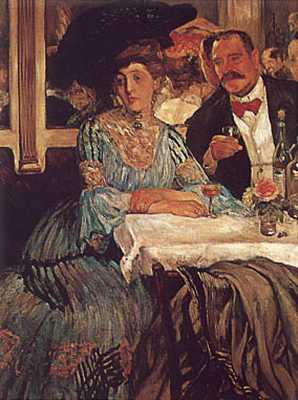 |
William Glackens |
|
home | Back to Thesis (page 3) | Ashcan School |
|
 |
William Glackens |
|
home | Back to Thesis (page 3) | Ashcan School |
|
 |
William Glackens, Chez Mouquin, 1905, Oil on canvas, 48 x 39in. Art Institute of Chicago |
The following imformation was copied from pages 428, 429, and 430 in:
Craven, Wayne. American Art: History and Culture. New York: Abrams, 1994.
Philadelphia-born William Glackens (1870-1938) worked as a newspaper illustrator, falling in with John Sloan, Everett Shinn, and George Luks. Like them, he studied with Anshutz at the Pennsylvania Academy. In 1895, Robert Henri encouraged the younger man to accompany him to France. Although he never enrolled in any art school while abroad, Glackens sketched the joyous life of the Parisian boulevards, and became acquainted with the art of the Impressionists.
Returning to America, he settled in New York City, where he shared a studio with Luks. Glackens too a job as a newspaper illustrator, but it turned increasingly to painting as his career. His early masterpiece is Chez Mouquin. Mouquin's was a popular cafe frequented by artists, writers, and young men-about-town. Members of The Eight dined there frequently. In coloration, technique, and subject matter, the picture recalls impressionist paintings set unpopular Parisian nightspots, and depicts life among the demi-monde society. Glackens represents it in a manner reminiscent of Edouard Manet's A Bar at the Folies-Berger(1882, Courtauld Institute, London), showing a wonderful still life on the table and reflections of the glittering room in the mirror behind the figure.
Like the French Impressionists, Glackens also depicted the pleasant side of life--strollers in parks and along boulevards or people enjoying a carriage ride on a sunny afternoon. He exhibited his work with The Eight in 1908, and two years later sent pictures to the exhibition of the Independent Artists,. When the Society of Independent Artists was organized in 1917, Glackens was elected its first president. About this time, too, he was assisting his longtime friend, Dr. Albert C. Barnes, in the formation of his collection of paintings of Degas, Manet, Renoir, and others of the modern French school. As time passed, Glackens's work increasingly took on the lighthearted character of the Impressionists, rather than the grim hues and bleak scenes of streetlife as portrayed by his friends Sloan and Luks.
|
Back to Top | Home | Back to Thesis (page 3) | Ashcan School |
Armory Show Web Site
Linda M. Larson. All rights reserved.
Revised: 29 Nov 2000 14:30:28 -0500 .